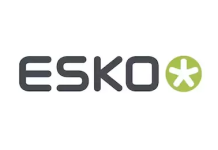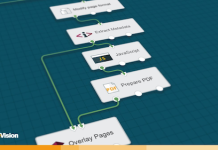Swiss company STEWO had its LUCERNA CONCORDE SCHIAVI 6-colour gravure press upgraded by BOBST with a Registron® S6100-D register control system, and the latest drive and control technology. The company produces most of its wrapping paper using this machine.
‘In the past, our machine operators always had to keep an eye on the color register. Nowadays, they can devote the time to other aspects of the gravure printing process. The Registron® S6100-D does the complete job. You can rely on it’, explained Tobias Brun, Head of Technology at Stewo International AG in Wolhusen, Switzerland.
‘The accuracy of the print register is controlled much more dynamically and, above all, proactively. Neither acceleration and deceleration nor splicing register errors occur. With the new register control system, we achieve significantly higher stability in printing. It is now much easier for us to achieve the print quality we are aiming for’, said Brun, emphasising the crucial advantage of the upgrade.
The register control system reliably measures web stretch and tension and automatically triggers preventive corrections before register errors occur in the gravure printing process. BOBST has developed special algorithms that make this possible and are unique on the market in this form. Another reason why register control today can proactively exert a corrective influence on the printing process is the interconnectivity of the printing units and thus also of the Registron® S6100-D system components. They communicate with each other.
The most reliable readings
The performance of sensor technology plays a key role in controlling the color register during gravure printing. It needs to be able to reliably read the print marks it uses to control the process – even under difficult conditions. The new register control’s RGB sensors give STEWO flexibility that they had never previously had. They can recognise the print marks straight away, even with low-contrast inks, metallic inks and coatings, and on hologram paper.
One example is an aluminum-coated wrapping paper that STEWO prints with six colours. In order for the sensors of the previous register control to detect the print marks on this material, a strip of white ink used to be printed in front of the aluminum coating. ‘So in the end, we printed the paper with seven colours. Since our gravure press only has six printing units, it had to run through it twice’, Brun reflected. The aluminum coating is not even a challenge for the Registron® S6100-D sensor technology. The white stripe is no longer needed; the wrapping paper is produced in one process.
Less waste with more operating convenience
‘With the Registron® S6100-D, we are significantly faster in the register and therefore in our applications. We have shortened our start-up waste from 500 meters to around 200 meters’, said the Technical Manager, citing a specific figure. In general, waste has been significantly reduced since the upgrade. As well as the higher level of stability under pressure and the performance of the sensor technology, there is one other reason for this: the simple, intuitive and process-oriented operability of the new register control system with automated functions such as ‘Easy Start’ for its fast setup.
STEWO processes several very special papers and prints – many of them in six colours. In some cases, the rear sides of the wrapping papers are also printed in multiple colours. In the past, this required the input of various parameters when setting the register control. Machine operators can now select the functions and parameters they need from drop-down menus and see at a glance the options available. The Registron® S6100-D reduces the error possibilities of manual entries to a minimum.
Operator guidance is even simpler for repeat jobs. When creating new jobs, STEWO saves all register control parameters in reference jobs. They can subsequently be recalled at any time by pressing a key and the register control system adjusts automatically. But STEWO is also some minutes faster in printing new orders these days. The order sizes generally vary between 5,000 and 250,000 meters. Among them are many smaller orders. The time saved in the setup process has a particularly positive effect. Tobias Brun commented, ‘Purely from a time perspective, we have increased gravure efficiency by about 15%, including the shorter machine startup time. In addition, new employees can be trained much faster with the Registron® S 6100-D.’
The environment benefits too
With significantly reduced waste, the sustainability of the printing process and the wrapping papers has improved. The LUCERNA CONCORDE SCHIAVI was commissioned at STEWO as early as 1991. ‘We wanted to create production reliability for the next few years. In addition, the existing technology had been discontinued, so there was no longer any technical support for it. The time had come for an upgrade to the latest technology’, Brun reflected.
Thus, the company also asked BOBST to update the drive and control technology. Among other things, the existing DC motors were replaced with the latest AC motors with innovative drive technology from Siemens such as SINAMICS frequency converters including SIMATIC STEP 7 (TIA Portal). This technology, recommended by BOBST specialists, is characterised by the highest energy efficiency. For example, STEWO calculated an energy saving of 10% compared with the previous technology.
‘Register control is no longer an issue in our gravure printing process’, noted Brun. If worst comes to worst, the BOBST Competence Center is close by. In addition, he said, ‘the machine, including the automation technology, is connected to BOBST’s remote technical support.’
The statistical functions of the new register control system, in turn, provide the company with a wide range of options for further optimising the productivity of the gravure printing process in the future.
BOBST
www.bobst.com





















